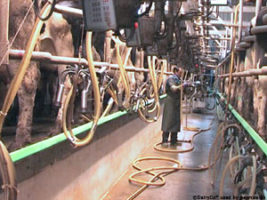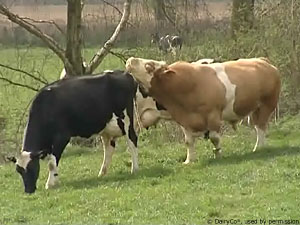What should your Voluntary Waiting Period be?
7 December 2020
The Voluntary Waiting Period (VWP) is defined as the interval after calving during which producers decide not to breed cows, even if they are seen in oestrus. The VWP should not be any less than 40 days to allow the uterus time to recover from a normal calving, eliminate any infection, return to its normal size (involute) and resume ovarian activity. After this stage, the cow becomes more fertile as she moves through the period of negative energy balance, and typically fertility will continue to increase until about 100 days in milk. Deciding on the VWP is a fine balance between serving cows as soon as possible after calving but allowing sufficient time to ensure good conception rates. Conceive too early and you run the risk of having to dry off cows still giving plenty of milk. On the other hand, getting the cow back in calf too late means that she will spend a greater proportion of time in late lactation where milk production is less profitable in relation to keeping cost and there is a greater period of time between lactation peaks, lowering lifetime production.
The VWP is an important consideration as it can affect conception rates to first service, lactation length and sometimes help to avoid failures of overall reproductive performance. Fifty days is a typical period of time to wait post-calving before rebreeding but can vary between herds depending on lactation number, yield, time of year and the use of synchronisation programmes to control oestrus cycles.
The VWP may be extended if a herd has excellent submission rates, whereas a herd with poor submission rates would be better to breed earlier if possible. Although excellent conception rates to 1st service may also allow a delaying in breeding after calving, it is advised that conception rates would need to increase by 6-8% if the time to first service is delayed by 10 days. The following diagram suggests an ideal VWP based on conception rates to first service and the service rate (oestrus detection efficiency):
Service Rate in the 1st Breeding Cycle (21 day) after the end of the VWP
| % | 50 | 60 | 70 | 80 | 90 | 100 | |
Conception rate to 1st AI within 21 days after the end of the VWP | 20 | 50 | 53 | 54 | 56 | 58 | 60 |
| 30 | 55 | 58 | 61 | 64 | 67 | 70 | |
| 40 | 60 | 64 | 68 | 72 | 76 | 80 | |
| 50 | 65 | 70 | 75 | 80 | 85 | 90 | |
| 60 | 70 | 76 | 82 | 88 | 94 | 100 |
For herds with animal monitoring technology, the decision of when to rebreed can be made on an individual basis. For example, high yielding cows slow to start cycling post-calving can be easily identified and given longer before starting rebreeding. Factors can be taken into consideration such as the number of oestrus cycles since calving, the intensity of oestrus and any health issues, as well as having a milk yield benchmark and cows being in acceptable body condition. A longer VWP (up to 20 days later) has been shown to be beneficial for conception rates in 1st lactation animals and their more persistent lactation curves means they are more efficient producers in later lactation than cows.
The following information can be used to determine whether you should extend your VWP:
- Heat detection rate. This should ideally be over 60%, any less and there will be more missed opportunities to breed cows.
- Level of production. Higher yielding herds (typically those over 8500 litres) benefit the most from increasing the VWP.
- Conception rate. Look at conception rates in cows bred less than 50 days compared to those bred between 50-90 days. If rates are significantly poorer in the early bred cows, consider increasing the VWP.
- In-calf rate. Review the number of cows open at 150 days (include cows not to be bred), with the aim being no more than 15%.
Although shortening the VWP may help improve the calving interval and improve 100 day in-calf rates by getting some cows to conceive earlier, factors affecting fertility should be reviewed as a whole, as it is likely that poor performance will be improved by a combination of factors, not just changing the VWP. Factors that can lead to suboptimal fertility include inadequate feed space, excessive body condition loss post-calving, poor heat detection and lameness prevalence in the herd. UK average 100 day in-calf rates are 50% but 65% can be achieved in well managed herds.
Related Resources
Sign up to the FAS newsletter
Receive updates on news, events and publications from Scotland’s Farm Advisory Service


